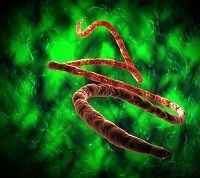Article
CDC: Ebola Fears May Have Caused US Deaths
Author(s):
US health care workers' concern over protecting themselves from Ebola infection may have compromised the care of some patients who turned out not to have Ebola, but whose care was delayed until Ebola test results were done. According to the US Centers for Disease Control and Prevention's Dec. 5 Morbidity and Mortality Weekly Report, at least 2 patients who tested negative for Ebola died from other causes.

US health care workers’ concern over protecting themselves from Ebola infection may have compromised the care of some patients who turned out not to have Ebola, but whose care was delayed until Ebola test results were done.
According to the US Centers for Disease Control and Prevention’s Dec. 5 Morbidity and Mortality Weekly Report, at least 2 patients who tested negative for Ebola died from other causes.
“Based on reports from health departments and health care providers, in several instances efforts to establish alternative diagnoses were reported to have been hampered or delayed because of infection control concerns,” the report said.
Those included lab tests for blood counts, liver function, serum chemistries, and malaria tests. In other instances patients did not get needed CT or ultrasound scans, or evaluation for noninfectious conditions, such as severe hypertension and tachycardia “reportedly delayed while a diagnosis of Ebola was under consideration.”
The report provided no details on where these patients were treated or the causes of death for the 2 patients.
“Health departments and health care workers should remain vigilant, but consideration of Ebola should not delay other indicated medical care,” the report said. Most of the report focused on the CDC’s Ebola statistics for July 9, 2014 through Nov. 15, 2014.
Despite the low totals of Ebola patients in the US, testing, surveillance, and other activities related to preventing the virus from spreading in the US has kept the CDC busy. The CDC tested 61 people for the virus, and found 4 were positive, including 2 travelers. (The statistics do not include the Nov. 17 death of Martin Salia, MD, a surgeon airlifted from West Africa too late to survive Ebola.)
But the number of tests the CDC did represents only 9% of the 650 cases referred to the CDC by concerned clinicians.
Of 17 people who arrived in the US from an Ebola-affected country after state-based active surveillance began, none had Ebola. The report notes that “appropriate medical evaluation and treatment for other conditions were noted in some instances to have been delayed while a person was undergoing evaluation for Ebola."
In a map in the report, the CDC notes that 2 states, Texas and Georgia, were the source of the most clinical inquiries (≥50 apiece), while California, Florida, Virginia, Maryland, Ohio, and New York each made from 20 to 49 such requests.
Since July, the CDC has helped state and local health departments develop the capability to test for Ebola. As of Dec. 3, there are 44 laboratories in 39 states that can do the testing. The most common alternative diagnosis for suspected Ebola cases was malaria with other viral illnesses including flu also common.





